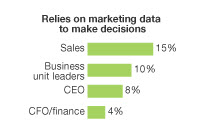B2B Marketing Measurement Needs To Sharpen Its Business Acumen
"Marketing measures its performance to prove its value, not to improve it."
Let's face it — marketing is often accused of poorly demonstrating it impact on the business in terms that business executives understand and appreciate. Even though advances in marketing automation and digital channels make it easier to track activity and results, this reputation persists and keeps many B2B CMOs from commanding a strategic seat at the leadership table.

Yet B2B CMOs can't continue to rely on measures like brand awareness, trade show scans, or website traffic to demonstrate the benefit their departments deliver. Those who do will be shown to the door as CEOs and CFOs raise the bar on accountability — and getting the right attention here is a substantial challenge when so few execs rely on marketing data in their decision making (see figure to the right.)
In May, Forrester teamed up with the IT Services Marketing Association (ITSMA) and VisionEdge Marketing (VEM) to survey marketing leaders about how they demonstrate marketing's impact on the business. About a week ago I (finally) published Forrester's take on this important survey (subscription required).
Key among the findings: marketing leadership continues to use metrics to report on performance and justify budgets. But far fewer use data and analytics to analyze purchase patterns, fine tune the mix, and understand customer lifetime value – actions that can have a bigger impact on overall performance. The bottomline here is that marketing's impact doesn't matter if CMOs fail to link what they do to business goals.
To help CMOs shift their measurement perspective from outputs to outcomes and to put a sharper focus on business agility, I recommend four key actions to take:
1) Clarify which outcomes the business wants. CMOs should answer three key questions about every activity or program that marketing reports to executive management: i) Which business outcome(s) will it affect? ii) How exactly will it affect the business? iii) How will we know we have achieved the objectives? Answering these questions keeps marketing performance management focused on improving the value of marketing, not just proving it.
2) Go beyond ROMI to expose the full scope of marketing's influence. Marketing automation systems make it easy to collect data but B2B CMOs need look beyond leads to include preference, loyalty, market share, and brand sentiment to show marketing's full impact on the direction and health of the business.
3) Model and monitor customer lifetime value. Think through the processes and tools you need to help your firm understand what makes customers valuable in the long run. Then shift some 2014 marketing budget to focus on communicating targeted messages and offers to prospects that closely fit this profile.
4) Measure existing customer value as well. Take a look at what happens in buyers' journeys after the deal closes and focus account-specific communications on onboarding success, getting up to speed quickly, and upsell opportunities to demonstrate how marketing can improve renewals, share of wallet, and penetration.
Take a look at the report and let me know about the challenges you face when showing why marketing is the next frontier for shaping business productivity.
